
Family. Reverence. Sadness. Pride. Home.These are some of the many emotions shared by those who have deep connections to San Antonio Missions. “We’re Still Here: Mission Descendant Stories” puts faces to the oral histories and memories of mission descendants in San Antonio. The exhibit recognizes families that have deep connections to these missions. These families make the missions a living community. Descendant families come from a diverse group of Texans with combinations of Indigenous, Latino, and European heritage. San Antonio Missions National Historical Park preserves and protects architectural, archaeological, and landscape features that demonstrate a complex interweaving of cultures that prevails in this community today. It is the only UNESCO World Heritage Site in Texas. Explore these descendant families' stories: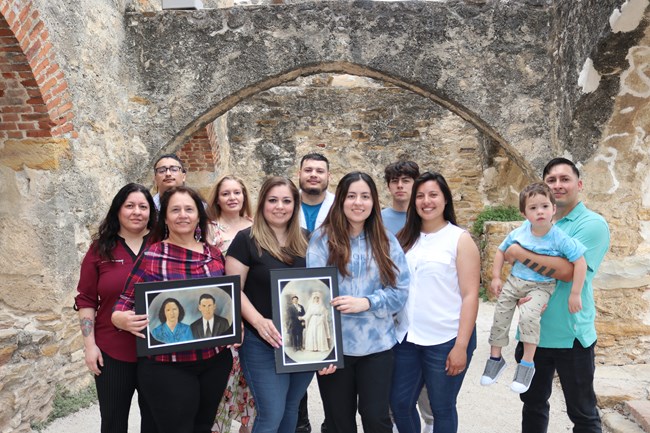
NPS Photo When asked about her connection to these missions, Dora said:"My connections are my greatest grandparents Luis Nombrano Casas he married Concepción Zamora Diaz and she’s Lipan Apache, she was born here in Mission Espada. [...] My parents always talked about us being Indians all the time but they... for some reason... they wouldn’t talk about being native/indigenous. They always used to say we’re Indians, but we never knew what type. So I started doing this research." On how the missions make her feel:"It makes me feel emotional when I walk into the missions, because my ancestors were born here and it’s just overwhelming." 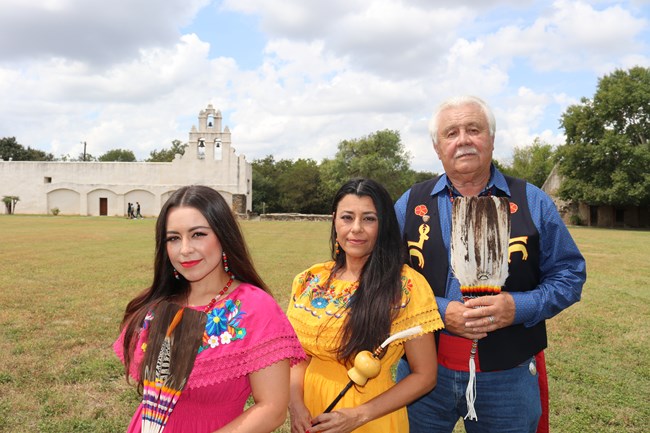
NPS Photo On what it feels like to be on the mission grounds:"It's such an emotional feeling knowing that I am walking lands that my grandparents, their parents... and going back to recorded history in some cases 12 generations. Each step that I take I feel the energy that goes through my body. I can’t explain it." 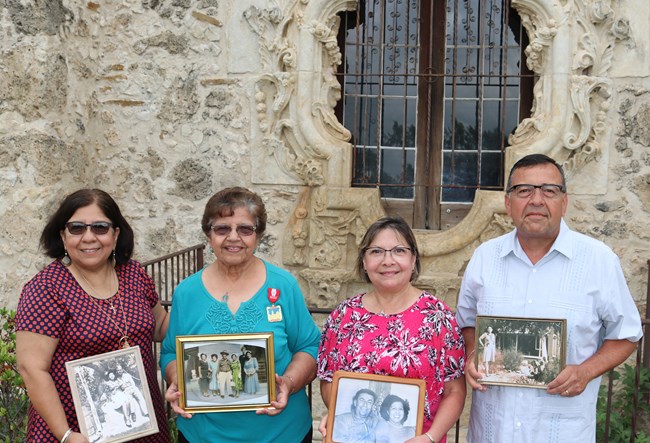
NPS Photo The family shares the story of a house being moved more than 100 years ago:“Well Francisco and Tia Dora were married in 1901, and they initially built there house right there near the granary and the acequia and they moved it in 1912. They put it on rollers, and my Aunt Suzie remembers, she was a child, she was 4 years old, and mules were taking the house. She remembers waving at the house as a child. The house went a mile away, Northwest from here and it was Bustillo property. They had additional farmland there and it was a land grant. They lived there, they raised their 8 children there, that where their homestead was, and now it’s Bustillo Drive. Only one room was left of the original homestead and its part of the house that was remodeled in like 1915." "And that’s her house” "And to this day there are still a number of cousins living on Bustillo Drive.”Click here for more. 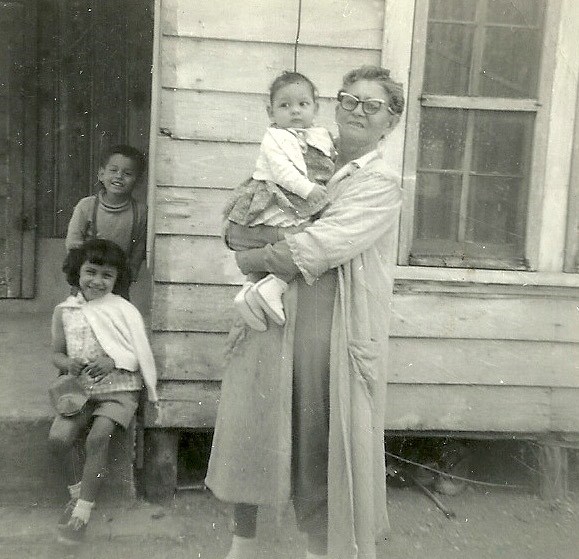
NPS Photo Both Debbie and Brenda reflect on their house right behind Mission San José:Debbie shares, “I remember a lot from my childhood growing up behind the mission. One thing that was enlightening once I got older, basically when we had to move, was not really embracing and understanding the value of growing up where I did. When I was young I took it for granted, it was a home. I didn’t think about it being historic. At school they would take us to the missions, and to me it was like, 'What’s the big deal. It’s a mission, San Jose Mission'. I lived behind it. [...] Growing up in the house that you see where my grandmother is holding me, I remember the porch, I remember the doors, I remember just growing up in that home." 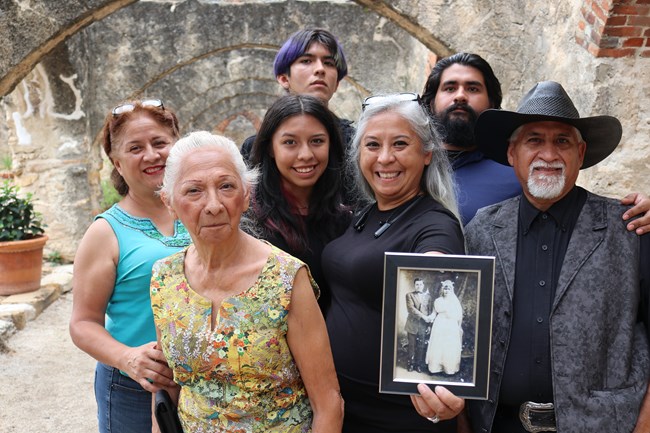
NPS Photo Margot and Diana explain how it feels to visit the missions:“It’s so cool to know that my ancestors lived here, and these steps that I walk on, they probably walked these same steps. On the other hand, the more that we’ve learned and the more that we’ve studied, I’ve read that the Indians would try to leave and they’d force them to come back. And some of them so many times. In fact there was one case of a Indian who killed a priest [...], but when you study it he’d been forced back three times, and I think how is that possible, that’s kidnapping. You're forcing these people. How many of them truly wanted to be here? Or how many of them just got tired of fighting and just decided to stay? [...] I understand that out there, they were fighting with a lot of different tribes, I understand that." “But that was the fight that they chose”. “That was a part of their life, they understood that, but here some of them probably did come willingly because there was food and they didn’t have to wander around... but they were nomadic, they were used to going wherever the food was. I wonder did ours come willingly, or were they forced to come?"Click here for more. The family asked their mother, Noemi Moreno to sing the native song that she and her mother would sing to their children:
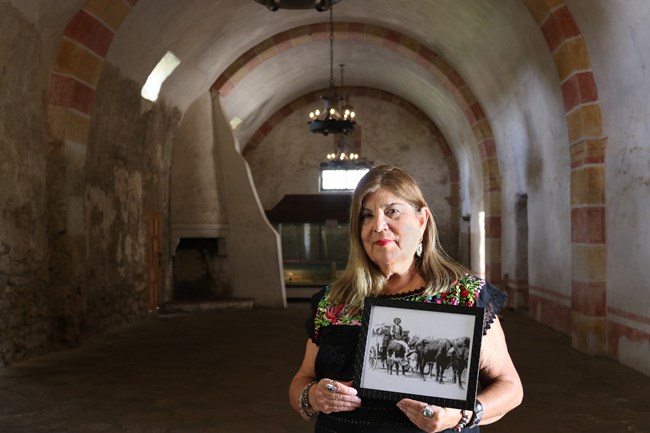
NPS Photo Reflecting on her ancestors who were soldiers, Nancy shares that:"My ancestors were the ones that helped protect and help the priests in any way they needed, especially to run errands, bring supplies and to chauffer them. When the priests traveled, the soldiers protected them." "We defended Texas under every flag. [...] We have a long history of being military. They were here under every flag."When Nancy visits the missions, she often looks "at the kitchens and the cooking stoves outside, [and] I wonder about the women because mostly we hear about what the men did. It was a man’s world, and for many reasons as it still is in many ways, women have to be more protected and guarded because of the things that go on […] that’s what I feel the most awed by, the role of the women and how strong they must have been […] I think about the women and the children, and how they had to be very strong, and quiet.” 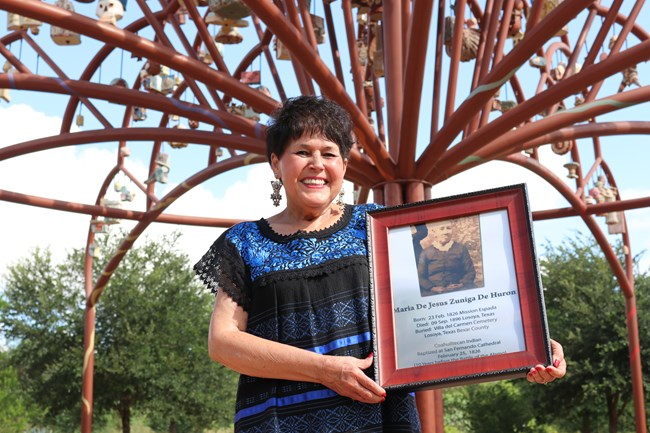
NPS Photo How Estella feels when she visits the missions:"As I enter into any of the missions, I feel a connection to my ancestors who walked and lived their lives on these same grounds and more than 200 years ago. This is amazing. And to think that my Coahuiltecan Indian ancestors built the missions, one stone at a time, and created the magnificent structures that we see today. They’re still standing after 300 years. It’s a testimony to their determination.And you know, the priest were real good about recording the activities of the Indians as they farmed this beautiful land, and they took care of the cattle, and built acequias to irrigate the farmlands. The spirit of my family remains.” Click here for more. 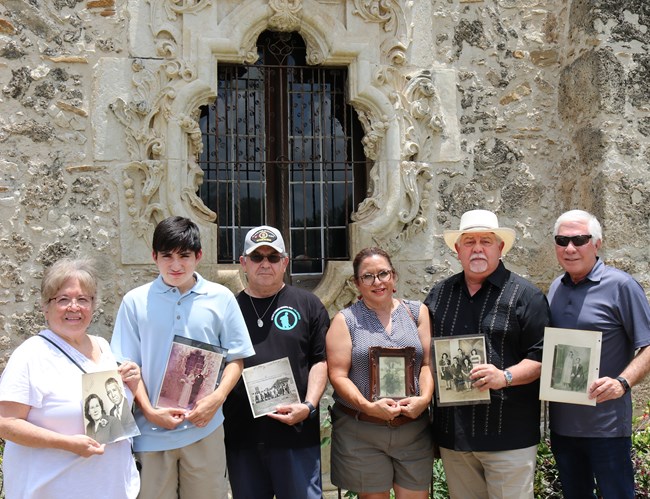
NPS Photo Reflecting on Mission San José, the family explains:"It’s a church, but it’s more than a church because I also know that some of our ancestors lived here, some of our ancestors are buried on the grounds, so it’s hallowed property when you walk in." 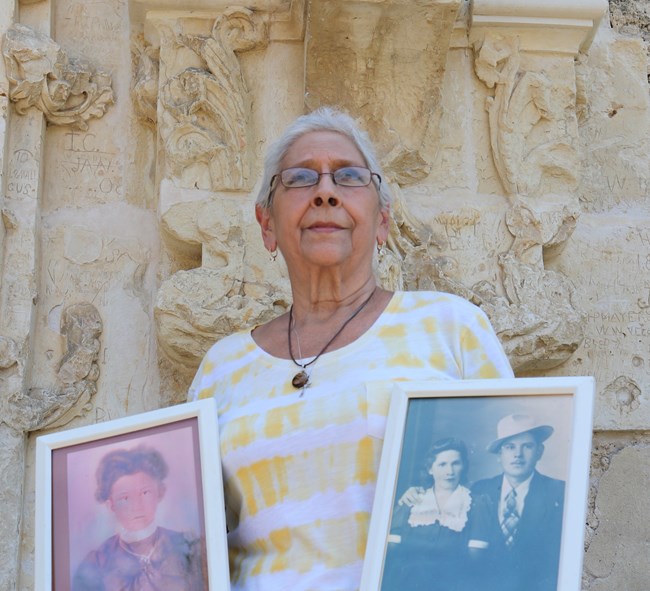
NPS Photo Speaking about the missions, Olivia shares:"We were born and raised around here, all the people around here, this was like a little town you know, and if you left here to go to another missions it was like going to [...] another little town around, cause they weren't far they were just little places we went to visit." Reflecting on the languages she speaks:"This is not our language, that I'm speaking right now. Ni mexicano, nada de eso! No es. La lengua de nosotros es una idioma de los indios. Porque somos indios. [Not even Mexican, none of that! It is not. Our language is a language of the Indians. Because we're Indians.] You know... " Click here for more about Olivia's family.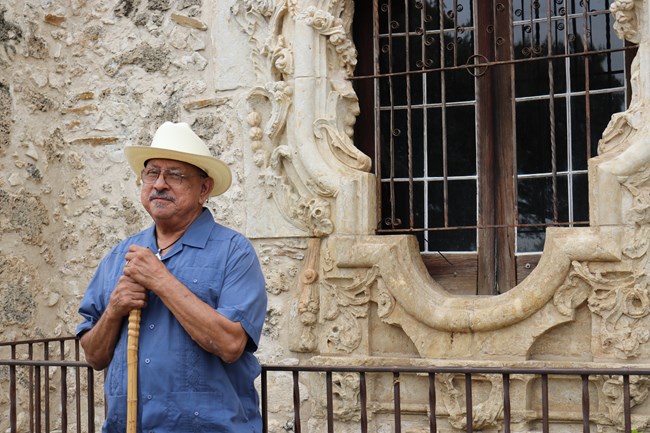
NPS Image Speaking about his ancestor Pedro Huizar:"...we found out, through my geneology and I was doing research, that Pedro Huizar got here around 1770. [...] He was sent to La Bahia in Goliad to do surveying on how to get water into that mission. He wasn't just a carpenter per se for the missions; he was a stone worker, stone carver. He had to have been like a blacksmith so he could do artillery pieces for the province. [...] I found paperwork where he was asking for payment of artillery pieces that he had built for the province, gun carriages. [...] And then he did surveying. On some documents we found that he was known as El Maestro, and that's somebody that knows more than just one skill. [...] It's weird when you walk into the missions and you know that your ancestors have something to do with it."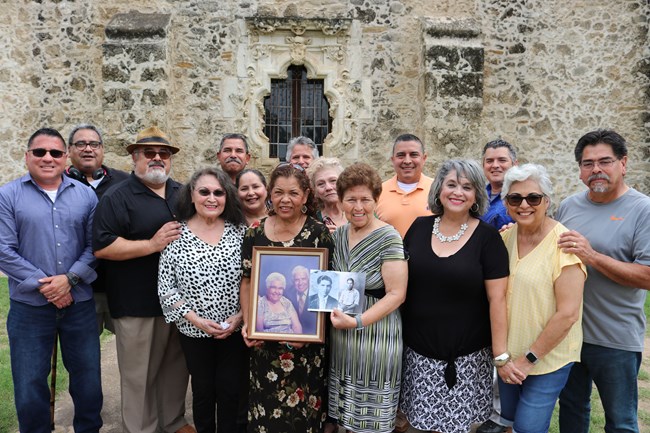
NPS Photo As they walk towards the church at Mission San José, the family shared:"I love coming here, it’s home."
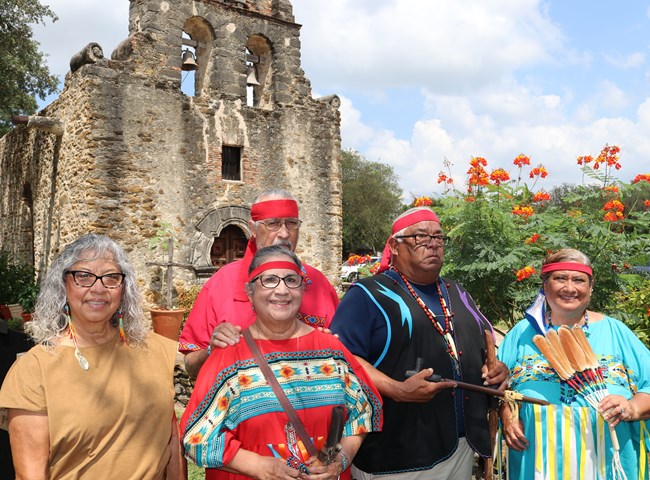
NPS Photo Epifanio explains his connection to the missions:“Somos puro sangre”, which means “We are blood.”"We’re still here, cause I’m not leaving. We’re ghosts sometime, but we’re not. We walk amongst everybody. […] If the people that come here, realize that we’re still here […] just to make sure they tell the true story about us. […] but you know it’s beyond that. It’s like my brother and sister said, you walk and you’re actually walking on sacred ground, on holy ground. You’re walking on a burial here, because a lot of times we don’t know where our families were buried, other than the stories that are told about our great-great-grandfather that was buried in the steps of the mission.” 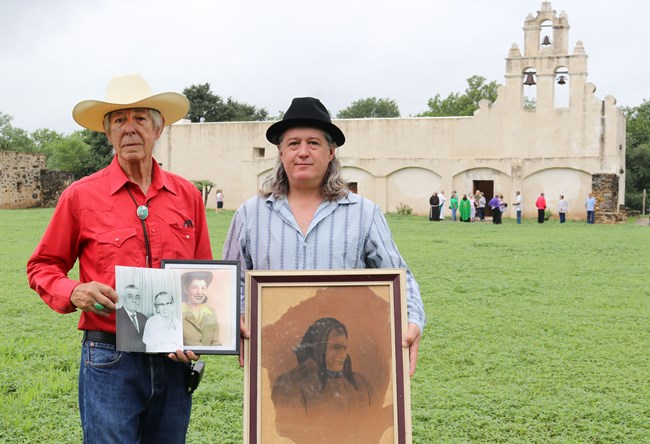
NPS Photo Mickey reflects on his connection to the missions:"My life encompasses just a small part of the total evolution of this area and the peoples of this area. We start off with the Native Americans here [thousands of] years ago, and then we have the confrontation with the Spanish in 1700s, and then it’s an evolution. The Spanish try to convert the native, and the natives went along with the Spanish and they lost most of their Indian culture and we evolved, slowly through the generations we evolved, and here we are today, we’re different […] but we’re still here. The native people are still here and the original settlers are still here. Well, their descendants still are anyway."Click here for more. 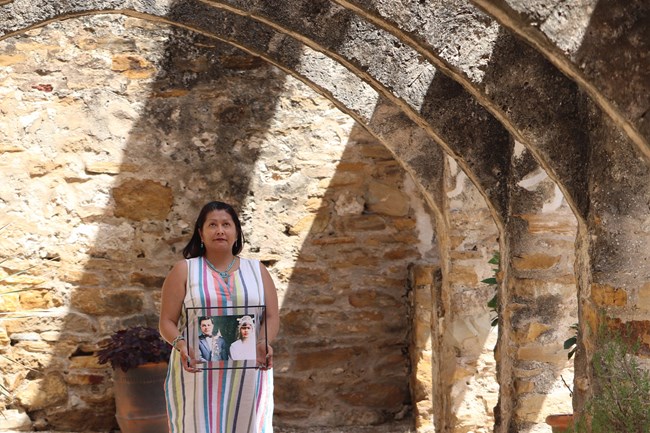
NPS Photo On the beauty of the missions:"Really if it weren’t for our indigenous ancestors' willingness to adapt, it wouldn’t be such beautiful of a place. We wouldn’t have such diversity and, certainly I wouldn’t be here." Speaking about her nieces:"They looked to me as their matriarch and their educator, seeing the pride and emotion on their faces, and knowing that I was instrumental in giving them that connection was just beautiful. My oldest niece, looked at me and she says “Now I know who I am.” … There is this big feeling of being an imposter because we didn’t know our roots, and I know it wasn’t intentional from our grandparents... I know it wasn’t intentional for them to hide this from us." 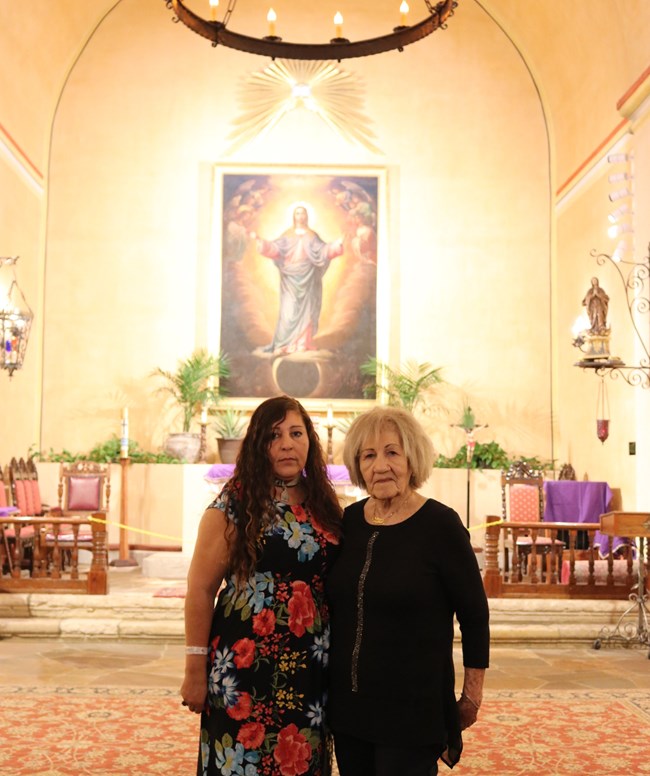
NPS Photo Susanna explaining her many connections to the missions and acknowledging her Afro-Native American roots:"Our African [ancestry] here in Texas goes back to the beginning, [from when people came into Texas through Galveston almost 500 years ago starting with Estevanico from Morocco.] In both my mother’s and father’s family, our African heritage comes from both west & northern [...] Canary Islands and as far as the Congo. It has been traced via documents going back as far as the gateway missions in particular, San Juan Bautista. And although, we may be a little bit of this, or a little bit of that, we were born here and hold closest to our hearts our Native American heritage albeit mixed in with the rest of our ancestry." [...] "My sister and I have said to our mother, 'Why don’t we go visit Africa, or let’s go to Europe?' She replies, 'Why would I want to go there? What would happen if I died there? I want to go back to the earth whence I came from and to which I shall return (referring to her native side) !' She continutes, 'Besides, there are so many beautiful things here that I am yet to see; why do I need to go elsewhere?'" Sharing one of her ancestral ties to the missions:"This is on the paternal side. me, sister Marina’s & my now deceased half-brother “Bobby”. The subject of my focus now, is on the Nunez family dating back to the 1700s in San Antonio, especially the Native American Pajalat Governor of this Mission [Concepción], his name was Miguel Nunez.There is also a Concepcion Nunez, along with my direct ancestor Manuel Nunez (born around 1760), whose records show that Manuel Nunez along with Concepcion Nunez are buried on the grounds of San Fernando Cathedral. Manuel's wife Brijida Trevino (born around 1756), is buried in the camposanto,under Santa Rosa Hospital I believe. Brigida Trevino, I believe, is the oldest Brijida in this tree. [Here is a picture of a later Brijida Vasquez, born in 1830, direct Nunez descendant.] It is a challenge deciphering the exact relationships for many names that are repeated and/or are used interchangeably. In addition, there were many battles being fought at the time and many records are missing, especially as it refers to Mission Concepción." |
Last updated: May 5, 2025
